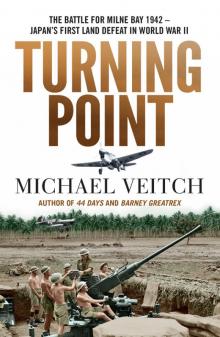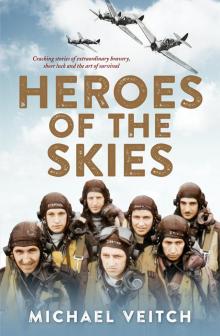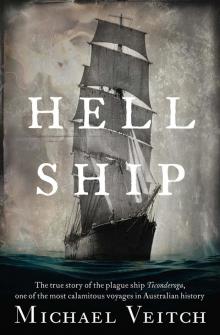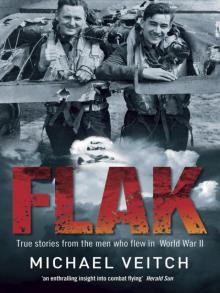- Home
- Michael Veitch
Flak Page 5
Flak Read online
Page 5
4
Alec Hurse
Bomb-aimer
For Conspicuous Gallantry
Alec Hurse lived in a tiny rural hamlet several hours’ drive from home that I took ages to find. I was late and bad tempered. Arriving at his house at the edge of a large dairy property, I sat in the car for a few minutes letting the stress of the drive seep out of me and trying to adopt a more positive attitude. Inside, I was shown into a living room where a table had been laid with napkins in silver holders and crockery of an old and satisfying vintage and at which I was the guest of honour. Peg, Alec’s wife of many years, had prepared a lunch of corned beef and vegetables. The meat was incredible. ‘Killed on the farm,’ I was assured.
Alec was a farmer, having spent his entire life on the land, minus a brief extraordinary few years in Bomber Command as a bomb-aimer on heavies. He spoke slowly but with the measured, rhythmic meter of one who has never had any use for hurrying. I adjusted my interviewing style accordingly. His powers of recall were astonishing and his considered answers delivered logically and in sequence. His mind was obviously as sharp as a tack.
The first real experience of England for most Australian members of Bomber Command was the resorts of Bournemouth and Brighton on the south coast. Here, in seaside holiday hotels, stripped of everything that hinted of their former peaceful incarnation (including the carpets off the floors), thousands of airmen were housed while the powers-that-be decided what to do with them and where they should go. Eventually, the steady expansion of the war effort and the relentless flow of casualties saw them dispersed to airfields right across the country. But for at least a few weeks, there was often little to do but drink the beer, meet the girls and wait.
Alec’s early experience of Bournemouth was slightly more dramatic. The Germans, knowing exactly what the town was being used for had long been planning to attack and one sunny Sunday morning, just as Alec had finished his lunch, they struck.
The first thing he knew about it was a line of cannon shell explosions tearing up the road just in front of him as he emerged into the sunny main street. Thirty-five Focke-Wulf 190 fighter-bombers had swooped in over the Channel and pounced, strafing and bombing everything in sight, including a direct hit on a hotel used by Canadian airmen, eighty of whom were killed. Bombs also fell in the park, killing people enjoying the sunshine.
At Alec’s Operational Training Unit in Wescott, near Reading, thirteen bomb-aimers, thirteen navigators, pilots and wireless operators milled around a hanger in the crewing up ritual. Alec heard a pilot mutter in a New Zealand accent, ‘I want one of these bloody Australians.’ ‘You’ve got one,’ he told him and thus became the sole Australian in Bomber Command’s only dedicated New Zealand squadron, 75, based at Mepal in Cambridgeshire.
I’d heard about the New Zealanders in Bomber Command. People had told me they were quieter than the Australians, highly professional, often tended to keep to themselves and drank less than the Australians.
‘I wouldn’t say that,’ said Alec, about the last point.
As a young fella off the farm, he was, to begin with, a teetotaller. On nights off, another crew would drag him down to the local pub.
‘Come on, Hurse, you’ll be dead soon,’ they said encouragingly. Soon after that, they were the ones that had gone.
‘I thought, I’d better start drinking,’ said Alec.
Alec began his tour in October 1943 on the Royal Air Force’s first four-engined bomber, the Short Stirling. I’d always liked the Stirling, but it somehow reminded me of a brontosaurus: noble, but enormous, ungainly and slow. It was built by Short Brothers to an extremely high mechanical standard and crews and pilots talk glowingly of its handling capabilities, relative comfort and an enormous ability to absorb punishment. One 75 Squadron Stirling even survived a head-on collision with a Messerschmitt 109 over Hamburg, losing 4 feet off its starboard wingtip but making it home with the pilot wrenching the control column as far over as possible and lashing it there with parachute rope.
But not many in 75 were so lucky, especially in the dark months of early and mid-1943. According to Alec, not a single crew on Stirlings completed their tour of thirty trips throughout the entire year. In fact, two crews were taken off operations after just twenty-one. It became known as ‘the chop squadron’. I ask Alec if he thought he’d make it through.
‘Nah. Not a hope,’ he answered without hesitation.
The fatal flaw in the Stirling was its dreadfully low ceiling, a characteristic in-built by a ludicrous act of governmental bureaucracy. When the RAF called for tenders for a four-engined bomber in the late 1930s, they stipulated the wingspan must conform to the existing dimensions of the standard RAF hanger, in an effort designed to save them the expense of building bigger ones. A classic story of ‘don’t raise the bridge, lower the river’. Hence – the Stirling’s wingspan was a mere 99 feet, 1 inch – far shorter than it needed to be – giving it a strange stumpy appearance and limiting its altitude to around 15,000 feet, far lower than its contemporaries such as the Lancaster or Halifax, a fact not lost on Alec when flying over the target.
‘You’d be dodging the flak from below, and dodging the bombs coming down from the Lancs above.’
Nor was it lost especially on Alec’s first flight engineer, a Scot. Unlike the Americans, the Royal Air Force did away with co-pilots and instead created flight engineers, often a former groundcrew whose job it was to assist the pilot when needed and also monitor the aircraft’s various mechanical systems, fuel, hydraulics, etc. On the Stirling, he sat up near the pilot and had roughly the same view. Alec’s first trip was a ‘gardening’ operation, code word for mine-laying in a German harbour or shipping lane. Gardening ops were often given to new crews, as they were regarded as being marginally safer targets than the big cities, especially in a Stirling. Nonetheless, the flak which came up to greet them was enough to make a very deep impression on the flight engineer. Back at the de-briefing, Alec remembers him announcing that flying was too dangerous and that he no longer intended to do it. The de-briefing officer looked at the man to determine whether he was serious, then quietly reached over to the phone. A few minutes later, two military policemen appeared at the door and escorted him to the guardhouse. He was charged with what was caustically described as LMF or Lack of Moral Fibre, a stigma often fierce enough to eclipse the fear of death itself. By the time Alec had returned to his barracks, the man’s belongings and gear had already been cleaned out as if he’d never existed. In reality he, like all dubbed ‘LMF’ would have been stripped of rank and entitlements and given the most humiliating and menial of tasks in an out of the way location – often cleaning toilets.
Unusually, Alec had lost his log book, making the interview a little structureless. Slowly going through a log book, examining the details of dates and places often revealed details hidden for many decades. Without it, I had to rely on Alec’s memory, which although excellent, didn’t give me some of the detail I was after.
I asked Alec if he had completed his tour of thirty.
‘Shot up on the twenty-ninth,’ he told me.
My ears pricked up. ‘Tell me about the twenty-ninth.’
There was a very long pause and a bit of a chuckle. Something about the pause made the hairs on the back of my neck stand up and I sensed the conversation was about to turn in an entirely new direction. For the next half hour I sat with a cold, half-drunk cup of tea in my hand, listening to the astonishing story of Alec Hurse’s last trip.
Log book or no log book, 11 June 1944 is a date Alec has never forgotten. 75 Squadron was part of a larger force attacking the railway junction at Nantes near the French coast on the Loire river. At that time it was a vitally important place for the Germans who were attempting to rush men and equipment north to join the battle in Normandy, still only a few days old. On arriving over the target, it was, contrary to the forecast, solid overcast. Having made it all the way to the target, aborting was something crews hated. Recently they had mad
e their way almost to the Swiss border on a supply drop to the Resistance, only to find the drop zone obscured by snow. The memory of having to bring everything all the way back was a bitter one. A brief discussion among the crew decided that it might be an idea to briefly duck below the clouds and see what was what. After all, the Nantes railway yards were a huge target and not easy to miss, especially as it had already been marked by the Pathfinders. Just head for the flares, drop and sneak back into the clouds. Should be easy.
The Germans also knew the railyards were an easy target and so when a lone Lancaster emerged out of the safety of the clouds, six searchlights fixed it like a moth in a spotlight. Then the flak opened up. They were low, so it was only the lighter stuff. However, from the nose, Alec remembers seeing the tracer coming up to meet them, then two big explosions. Then all hell broke loose. A voice yelled, ‘Get out, get out, they’ve got us!’ Then the plane started to climb.
‘Push the nose down!’ shouted Alec into the intercom, but the pilot could only yell back, ‘I can’t see, I can’t see, we’re going to crash.’ Alec let all eighteen bombs go in one big salvo to get them away from the aircraft and pulled his way up to the cockpit. There was blood everywhere and the pilot, wounded badly, was pulling the control column towards him, forcing the aircraft upwards. Alec gently restrained the pilot and pushed the stick forward, levelling out the aircraft. An explosion had torn into the side of the cockpit and Alec could see the pilot had been hit badly in the abdomen.
‘Get me out of here,’ he managed to mumble through the shock.
‘Just wait on,’ said Alec.
The flight engineer, though not as badly hit, had nonetheless taken a couple of splinters from the explosion and was acting ‘like a stunned rabbit’. It was left to Alec to fly the aircraft. He pulled up into the cloud but the flak gunners, sensing a lame duck, were following him.
We’re never going to get out of here, he thought to himself when the navigator came in over the intercom.
‘Get out of the target area, go south!’
But which way was that?
‘Just turn to port!’ came the voice, and Alec wheeled the big bomber around to the left.
The wireless operator and navigator managed to pull the pilot out of his seat and take him down the back of the aircraft where they dosed him up with morphine. Alec was now in charge. If they were ever going to get home, he was going to have to get them there.
After an SOS, there was radio silence for an hour, then an instruction from England: ‘Land Boscombe Down’. Boscombe Down, near Salisbury was, and still is, the RAF’s experimental aerodrome where aircraft and weapons both brilliant and ludicrous were tried and evaluated. Today, it boasts the longest runway in Britain, a runway which during the war, was made of grass, making it ideal as an emergency aerodrome where the chance of crippled aircraft catching alight from sparks was greatly reduced. Ideal, apart from the numerous hills that surrounded Boscombe Down, requiring anyone who landed there, emergency or otherwise, to be on their toes.
Alec’s rudimentary understanding of flying an aircraft got them as far as the aerodrome, which they proceeded to circle. But there was another problem. The place they had taken off from, Mepal, was 1,400 feet above sea level, and their altimeter had been set accordingly. Boscombe Down, much nearer the coast, was only 700, so their height reading of 1,000 feet (305 metres) in reality meant that they were a mere 300 feet above the ground, surrounded by hills. Not only that, but they were flying at night with a damaged aircraft, a wounded pilot and a very young bomb-aimer who had never flown before at the controls.
On the ground, Aldis warning lamps flashed red, indicating they were too low. Seeing them, Alec knew he must have been low, but how low? Uncertainly, he increased the aircraft’s revs to gain height whereas he should have in reality lifted the nose fast. After three circuits he decided to come in, despite the urgently flashing red lights around him. He landed too fast and the big Lancaster hit the deck at high speed, bounced and immediately took off again.
‘Too much pace up,’ he said dryly with his soft, punctuating chuckle.
He tried again and managed to get it down about halfway along the runway. Quickly, he applied some brake via a lever on the control column and it immediately swung left, risking the collapse of the undercarriage. Counter-applying some rudder, the aircraft came to a halt.
‘Cut the motors. Let’s get out,’ yelled Alec.
It was 4 am and freezing cold. The rest of the crew emerged, white as sheets, from their crash positions, backs hard up against the main wing span halfway down the fuselage and praying for dear life. A line of torches from the groundcrew led them away from the aircraft. An ambulance took out the pilot and cut away his clothes there and then.
‘The whole of his side was like pulp,’ Alec remembered. He didn’t think he had a chance but in fact the pilot survived and went home to New Zealand, where he died a couple of years after the war.
It was Alec’s twenty-ninth trip, his second last. It was enough. His tour was marked down as completed.
There was a long silence in the room as Alec, smiling slightly, fixed his gaze on the middle distance, remembering. I asked my first question in a long time.
‘Were you decorated?’
Almost inaudibly, under his breath, he said, ‘Conspicuous Gallantry Medal.’
I felt stunned. The CGM is an extremely rare decoration awarded to non-commissioned officers, an equivalent of the officers-only (and much more common) Distinguished Service Order. Originally a naval decoration, in 1943 it was opened up to the air force. Alec, a warrant officer, was a member of this very exclusive club. The RAF handed out a mere one hundred and three of them during the Second World War, of which only nine went to Australians.
I had never seen one before. Without a word, Alec got up and ushered me towards a table, then pulled back a cloth to reveal his decorations, mounted with the unmistakeable dark and pale blue ribbon and the head of King George VI, engraved with the words For Conspicuous Gallantry.
We chatted about other things. I can see that for all Alec’s quiet, measured responses, a lot has been stirred up in the old farmer. I’m curious to know what happened to his log book. Peg is clearing up, and provides the answer.
‘Burned it,’ she says.
I looked at Alec. He just gave me a chuckle.
5
Les Smith
Air-gunner
How come you’re still alive?
My interest in Les Smith was twofold. Firstly, he was the only person I have ever met who flew in the Battle of Britain, and secondly, he flew one of the silliest aircraft of the Second World War, the Boulton-Paul Defiant. Somebody, somewhere, deep within His Majesty’s Air Ministry back in 1935 had the startling idea that if you stuck a rearward-firing gun turret in a single seat fighter, you would surprise any enemy making a conventional attack from behind. And true enough. For about five minutes, which is about how long the Germans took to cotton on to the Defiant’s peculiarity. Add to the equation the enormous weight of the turret and extra man, as well as the resulting loss of speed and manoeuvrability without any additional engine power to compensate, and it’s not hard to conclude that the only thing the Defiant actually defied was common sense.
Actually, it was barely five minutes. The Defiant’s debut was with number 264 Squadron over the beaches of Dunkirk on 12 May 1940, when they managed to shoot down two German bombers who were probably curious about the thing sticking out of the top of the Defiant’s fuselage. The very next day, however, this same squadron lost four of its five aircraft to the German Messerschmitt pilots who found shooting down the cumbersome Defiants pitifully easy.
It was also a death trap. The Defiant’s turret was hydraulically powered, so anything which severed the hydraulic power line – like a German bullet, say – rendered it immobile, trapping the poor gunner and condemning him to almost certain oblivion should the aircraft be shot down, which it frequently was.
One of those gunners w
as Les Smith, though there was nothing particularly poor about him when I visited him in his Melbourne inner-city retirement village early one summer evening. Les was also the first Englishman I interviewed so I was curious to compare his experience to that of the Australians I had already met.
When Les joined the Royal Air Force just before the war (another thing that made him interesting) it was an odd organisation, only twenty years old, but having wasted no time in sycophantically adopting many of the traditions of its senior service partners, the army and Royal Navy. Despite this, it was openly sneered at by both as new-fangled, radical, even dangerous, and not really worthy of displaying the crown on its uniform. To that generation of young men which immediately followed the one which had been slaughtered in the trenches of the First World War, however, the air force was an infinitely preferable option.
Les was a short wiry, highly active man from Gravesend, still with a distinctive London accent and all the energy of a bee in a bottle. He met me at the front entrance of the village and escorted me on a whirlwind tour of the dining room and gaming facilities, proudly showing off the garden and water feature on the way through. Nearly exhausted I sat down and caught my breath in his room.
Like almost all air force volunteers, Les wanted to be a pilot, but as with the vast majority, it was not to be, and he was assigned to the pool of trainee wireless/air-gunners. Soon realising he couldn’t achieve the necessary speed on the morse key, he was relegated to ‘straight’ air-gunner and thus very quickly found himself in action at the height of the Battle of Britain in late 1940.
More has been written about the Battle of Britain than has ever really needed to be, but the idea of it still mesmerises me. Over the years, it’s become such a mish-mash of myth and cliché that it’s hard to distil the actual drama from the Pythonesque images of men with silly accents and even sillier moustaches. Legend has it that the German army wanted to invade England but wouldn’t even try until the British air force had been neutralised, so over the course of one particularly glorious summer, the two giant air fleets slogged it out high above the lovely fields of Kent, the only things standing between the victory-drunk Germans and defeat being a few hundred well-spoken Spitfire and Hurricane pilots. In reality, I don’t think the Germans could ever have invaded England by sea because they were not properly equipped to do so, and the Royal Navy was still dominant. But the fact that the Germans were defeated for the first time, albeit defensively, makes the Battle of Britain one of history’s true turning points.

 Turning Point
Turning Point Heroes of the Skies
Heroes of the Skies The Forgotten Islands
The Forgotten Islands Hell Ship
Hell Ship Flak
Flak Fly
Fly